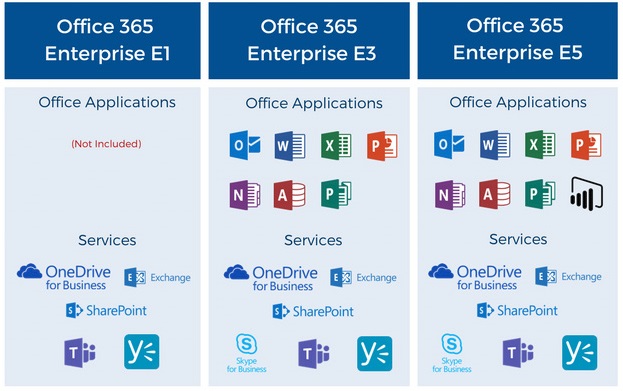Are you planning for a migration solution to improve quality performance and the IT environment within your organization? Perhaps you’re a business wondering if you should go for Office 365 implementation. Whatever your reasons are, before going to this implementation, you need to understand important information about Office 365.
Office 365, offered by Microsoft, consists of plans that allow users to use Microsoft Office software with the subscription. It also offers cloud-based software like SharePoint and Skype, perfect for any business environment. Many people use Office 365 for various plans across the globe with the efficiency it offers in different aspects.
Office 365 Enterprise plans included in Office 365 are E1, E3, E5, and Microsoft 365 Apps for the enterprise.
Office 365 E1
Among all plans, Office 365 E1 has the lowest price offering and costs each user $8. Only the web versions of the core Office apps and not the desktop Office apps are part of this plan. It is integrated with Teams and Onedrive and also includes email, file storage, quick sharing, meetings, IM, and intranet capability. Much more, it has five layers of security and monitors to ensure the safety of your meetings and data.
Microsoft 365 Apps for Enterprise
Microsoft 365 Apps for Enterprise plan, previously known as Office 365 ProPlus, includes Microsoft Office apps enterprise editions with cloud-based file storage and sharing. It costs $12 for each user every month with both web and mobile versions. Office 365 apps are always up-to-date, device and app management are enabled as well as identity and access management. Though it consists of a lot of advanced features, it does not support business email and lacks an intranet and advanced security capabilities.
For businesses that rely on Office 365 service like webmail can choose, this the best cost-effective plan for office 365 implementation.
Office 365 E3
All features of E1 and Microsoft 365 apps for enterprise are included in Office 365 E3 plan. It has a price of $20 every month for each user. Though pricy, the beauty of this plan is that you can install Office 365 on up to five PCs or Macs, tablets, and phones. There’s nothing to worry about such a feature since there’s additional security. Prioritizing your productivity, you are assured of its strong security and control features.
Office 365 E5
Office 365 E5 plan is quite similar to E3 but has more advanced features such as analytics, voice capabilities, robust security, and compliance features. Users have to pay $35 every month. Once the implementation plan was done, you can now create, receive, and transfer calls from any device, prevent yourself from cyber issues like spam messages and malware, protect sensitive data, and perform tasks effectively.
Moreover, If you’re aiming for the best, E5 offers a high level of security, compliance, and work productivity among all plans.
| Microsoft Licensing Plan | Price Per User Per Month |
|---|---|
| Microsoft 365 Business Basic | $5.00 |
| Microsoft 365 Apps for Business | $8.25 |
| Microsoft 365 Business Standard | $12.50 |
| Microsoft 365 Business Premium | $20.00 |
| Office 365 Enterprise F3 | $4.00 |
| Office 365 Enterprise E1 | $8 |
| Office 365 Enterprise E3 | $20 |
| Office 365 Enterprise E5 | $35 |
| Microsoft 365 Enterprise F1 | $4 |
| Microsoft 365 Enterprise F3 | $10 |
| Microsoft 365 Enterprise E3 | $32 |
| Microsoft 365 Enterprise E5 | $57 |

Planning your Office 365 Implementation
If you’ve finally decided on your business’ cloud move, Office 365 is the best place for this. You can now embrace the advantages of cloud-powered content management. You will get Microsoft business intelligence capabilities for smart business decisions using predictive analytics and increase team collaboration. In this section, you would learn migration solutions to ensure a smooth transition towards Office 365 and the things you have to consider as you plan your Office implementation.
In pursuing Office 365 implementation, you would need to create a project plan including cloud authentication solution and multi-factor authentication. Start by gathering information about your present IT infrastructure or environment. Collect the facts and figures, then analyze. You can assess your servers and their components, directory design, bandwidth, certificates, hardware and software, and more.
You must have a clear picture of why there is a need to implement Office 365 in your organization. Once you fully understand, you can develop effective deployment plans and learn the technology solutions needed. Inform everyone and create a deployment team that would help you enable this project plan.
You can get implementation support from Microsoft. It has automated Office 365 readiness checks. This evaluates if your business environment complies with the requirements and orient if any problems might hinder your Office 365 deployment. Another one is Microsoft Assessment and Planning (MAP) toolkit. This is a good source of implementation support that is also automated. You can use the multi-product planning and assessment tool for reports and hardware and software information. Through easily collecting data on your IT infrastructure and providing actionable advice, you can juice up your planning process.

In the first stage of implementation, you will have to:
- Create a strategy for your email migration plan and also your third-party toolsets.
- With regards to the network bandwidth, evaluate the mailbox size as well as the item counts.
- Determine the current content of your organization that should be migrated.
- Calculate migration velocity through testing network bandwidth or performance.
- Have a detailed email coexistence strategy.
- Develop communication plans for your implementation strategy, have clear instructions, and alert to ensure safe user adoption.
After completing the above mentioned, get ready for your Office 365 migration and implementation to the cloud. You would need to ensure synchronization by cleaning up your on-premises environment, and if it’s a hybrid migration, you would need to install Directory Synchronization Tool. Since you have planned the business-related content to be migrated, it would be easier to move them to Office 365. Note that it is also essential to consider a post-migration plan to make sure no member is left behind.
There are some cases that people face challenges with their deployments, such as access issues, mitigating risk, and data loss. Organizations with no access to the domains are likely to face issues with their access that can lead to some deployment delays. You must know your domain access since it is vital to start the Exchange Online deployment. For mitigating risks, the chances of encountering failures in various places are high. You can use third-party policies and solutions to handle if these risks arise. As for data loss, which is a major concern, you would need to have a backup plan since there is no guaranteed complete restoration of lost data. Protect your data from this possibility by relying on backup solutions.
In the end
To ensure a successful migration and office 365 implementation, all the relevant data and content should be available in the current environment. If so, you can now effectively facilitate communication and collaboration within your organization.
Office 365 and Azure Active directory
Some may wonder how Office 365 and Azure Directory differ from one another. As mentioned, Office 365 consists of popular software like MS Words, Excel, Powerpoint, and more, while Azure Active Directory Domain Services offers data services like storage, SQL reporting, SQL data sync, and SQL database. It also includes a remote app, virtual machines, cloud services, application services, and networking. Given its functionality, Azure AD is not considered a simple active directory. If you need to improve collaboration and productivity in your team, Office 365 is an excellent solution. If you need a platform that allows you use to manage your IT infrastructure, go for Azure. Office 365 and Azure AD are both useful depending on your needs. It also consist Azure Information Protection features for business information security.
Create a Digital Workspace with Office 365
Businesses and organizations need to cope with technological advancements, or they won’t last long in the crowd. Today’s digital world offers you a chance to create a digital workspace to meet your overall objectives and improve work performance. Here are some benefits of Office 365 for a reliable digital workspace:

Organized
You no longer need to do some bothersome work in keeping your records and documents organized. Office 365 doesn’t limit you to one function; it works with different programs such as Outlook, Word, Excel, OneNote, Publisher, and PowerPoint. Also, this allows you to synchronize your documents with your desktop, allow members of your team to edit or check-in and out your online documents with its collaboration tools, and launch PowerPoint presentations.
Accessible
One thing that makes Office 365 an excellent digital workspace is its accessibility. With the internet and any gadget, you can access your email, contact people, have a detailed calendar, and access relevant documents. Even at home or on business trips, With feature like mail archiving, mail routing, file sharing, Office 365 doesn’t let you left behind since you can easily access and edit documents, collaborate with colleagues and clients, and participate in online video conferencing meetings. With Office 365 implementation, you get all the modern device management capabilities with Office 365.
Less Complexity
Whatever generation you are, you can easily learn how to use Office 365, there is no compulsory requirement for end-user training. Unlike other software, there’s no need to install other unnecessary systems or learn new jargon. That’s why it is ideal as a digital workspace. It allows you to see how your business can be “in the cloud” at the same taking advantages similar to larger organizations. Even if you don’t have advanced IT knowledge, you can easily set up, activate, and use features that will help you perform administrative tasks. You can quickly start using Office 365 with the easy step-by-step instructions provided. For years, Microsoft Office 365 has delivered many convenient online solutions. These solutions and advanced features are easy to use and guarantee a quality Office experience even at a small-business price.
Secured
Most organizations value safety and security- the same goes for Microsft data centers security. Your emails, documents, and networks are protected with advanced security services and stringent security controls. It allows you to use the same systems used by Microsoft and other organizations across the globe, which spare you from malware and spam emails.
Flexibility
Lastly, A flexible workspace with personal cloud storage can conquer all. Office 365 provides you the professional services you need to add value to your business. Upgraded work performance is expected with its flexibility and availability. Much more is that its design tools can improve your branding and create a positive outlook for your business or organization.
Conclusion
If done correctly Office 365 Implementation can be well organized and planned. This helps foresee any potential hiccups in the implementation and plan your team accordingly. You can also avail Office Migration services where experts of Office 365 comes with loads of experience and helps organization take their business in cloud.










